Make all the jokes you want about forecasting the weather, but thanks to the work of early aeronauts and meteorologists, weather forecasting became not only a reality but a godsend for the world; not to mention giving meaning to the term “weather balloon.”

Focusing on a specific event which occurred on September 5, 1862, when meteorologist James Glashier “hitched a ride” in a balloon belonging to aeronaut Henry Coxwell, THE AERONAUTS fills us with all the wonder – and fear – that Glashier and Coxwell must have felt as they ascended to the heavens, going higher than any aeronaut had ever flown and opening up new meteorologic wonders to scientist Glashier and ultimately, the scientific community. Coxwell had been working as a balloon taxi-service for Glashier since 1860 with Glashier always the passenger along with his multitude of weather measuring devices, and in this instance, pigeons. Travelling more than 37,000 feet – about seven miles – up into the air, the two not only suffered balloon sickness with Glashier passing out around the four-mile mark, but the valve that would allow the balloon to descend was caught amongst ropes and ice formations on the balloon due to the frigid air temperatures. Coxwell was forced to climb out of the balloon basket and up onto to the balloon in order to release the valve. History documents that Coxwell used his teeth to release the valve.

As if just reading about Glashier and Coxwell and this September 1862 adventure isn’t exciting enough, producers Todd Lieberman and David Hoberman team up with director Tom Harper and writer Jack Thorne to bring this story to the silver screen. While the jury may be out on whether or not removing Coxwell and replacing him with the fictional Amelia Wren is acceptable, by taking some literary license with history and replacing Coxwell with a female aeronaut (of which there were quite a few throughout history), the story opens itself up and allows for some added themes of feminism that are as timely today as in 1862; and it allows for a reteaming of Eddie Redmayne and Felicity Jones. The story is just as exciting, and perhaps even moreso, with Glaisher and Wren over history’s Glaisher and Coxwell.
One of the most beautiful and visually exquisite films of the year, THE AERONAUTS is a true cinematic experience! It must be seen on the big screen.
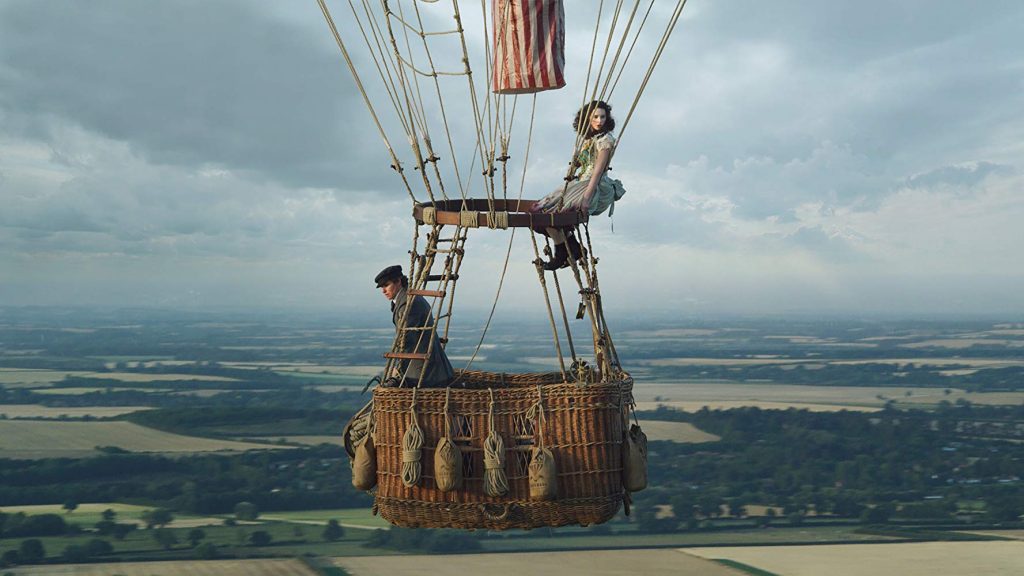
From the beauty and the fury of Mother Nature to dancing yellow butterflies 20,000 feet up in the air to the whispers of snowflakes, to the unfiltered warmth of the sun, to the crystalline clarity of twinkling stars on the rich blue-black canvas of 37,000 feet above the Earth, this is the adventure of a lifetime. And please, after seeing THE AERONAUTS, let no one ever criticize a woman or her shoes ever again! THE AERONAUTS soars!
There is no denying the chemistry between Jones and Redmayne. We saw that in spades with “The Theory of Everything.” As was the case in the Hawking marriage in “Theory” with Jane taking the reins of Stephen’s care and in running the family and household while pushing him ever forward, here we see Jones infuse similar strength and confidence into Amelia Wren. Not without her own issues following the death of her husband who sacrificed his life for that of Amelia during their last balloon adventure together, Jones brings a devil-may-care tone to Amelia as she treats this adventure with Glaisher as a show rather than with the seriousness of scientific purpose. There are moments in which Jones makes us feel that Amelia has a death wish, wanting only to join her husband in the beyond. But when push comes to shove and the survival of Amelia and Glaisher is on the line, her own survival instincts takes hold, leading to the most dramatic scene in the entire film.
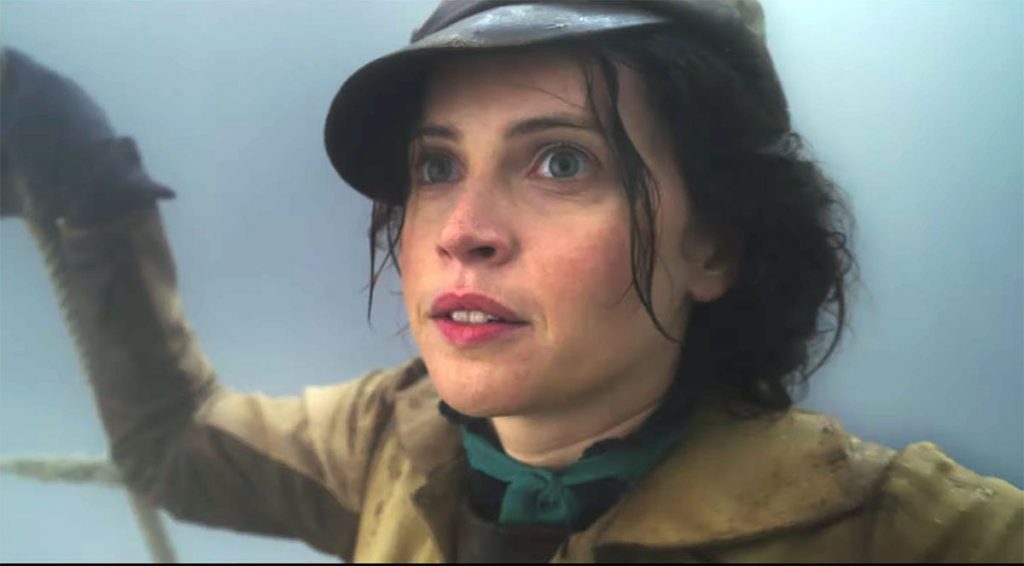
Dare it be said that one is on tenterhooks and the edge of their seat as Amelia climbs out and up onto the balloon to release the frozen and stuck valve while Glashier is unconscious in the balloon basket. A perfect combination of cinematography, VFX, and Steven Price’s score has one riveted to the screen, holding their breath with every inch that Amelia climbs. And yes, forget about Coxwell and his teeth, long live a woman and her shoes!
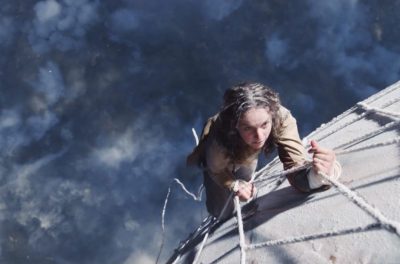
Eddie Redmayne plays perfectly against Jones and the inherent strength she brings to Amelia Wren. It’s a wonderful dynamic that challenges the stereotypes and preconceived notions of the day about women, while Redmayne actually takes a back seat to the drama of the aeronautical voyage, Mother Nature, and Jones. Amelia Wren feels like the lead character with Redmayne’s Glashier in a more supporting role. That’s not to say that Redmayne doesn’t bring his own gravitas to the proceedings. He does that in spades as he hones in on the idiosyncrasies of the scientist and the nature of the beast while capturing the wide-eyed wonder of some of Glashier’s discoveries on the ascent, and fears on the descent once Glashier regains consciousness.
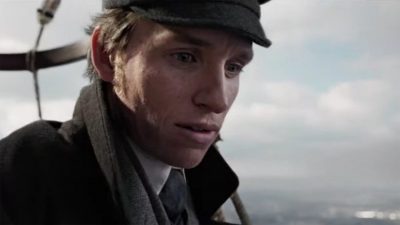
90% of the film is Redmayne and Jones in a 5×5/6×6 balloon basket and they make the most of it.
Stealing your heart is Tom Courtenay as Glashier’s father Arthur who suffers from old age and the onset of Alzheimer’s. Make sure to have tissues with you as watch Redmayne and Courtenay together who have some of the most poignant moments in the film. Not to be overlooked is Himesh Patel as Glashier’s best friend and colleague, John Trew.
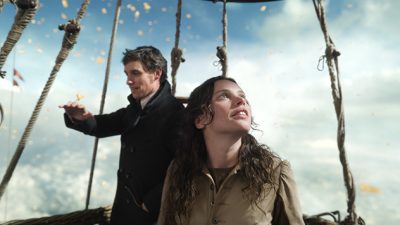
George Steel’s cinematography is exquisite. What he did with black on black and negative space in “The Woman in Black 2”, he does here with white on white as we dance high up into the clouds. While moviegoers are used to seeing airplanes and helicopters up in the sky or skydivers, we are never truly shown the actual atmosphere and the beauty that unfolds with each layer of the stratosphere. Here we see the eye-popping, jaw-dropping beauty of textured layers of white, mist, rainbows, unfiltered streaming sun with no ozone layer blocking it, and all countered by the fury of Mother Nature with raging snow, frigid temperatures, thunder, lightning, torrential rain. Knowing that Jones and Redmayne were 2000 feet up in the air in a balloon basket while being lensed from a helicopter just adds to the emotional authenticity of this experience. We are immersed in this basket, in this other world, with Amelia and Glashier.

Notable is that thanks to his framing, varied angles, and camera dutching, Steel makes the basket feel much larger than it is which, interestingly, translates into making this aeronautic world both intimate and expansive. Steel celebrates the production of David Hindle and Christian Huband, covering every corner of the basket and each item within it, some scientific for Glashier, others necessary for aeronautics, but each important in their own right. On the ground, we are privy to the making of the balloon for this specific adventure, seeing the true expansiveness of it when laid out during its construction in a huge warehouse. We continually see metaphor within the film reminding us of the largess of the world and our universe.

The VFX is exemplary as it complements Steel’s cinematography.
Action sequences, most within the basket, are well executed and choreographed, and then cut with rapier-precision by Mark Eckersley, immersing us in the direness and urgency of the situation and unfolding events.
Sound design is beyond striking and is a key element in THE AERONAUTS as there are moments when there is no sound. The universe is still as if frozen in time or inside a bubble. Extremely emotional and powerful. You get the full essence of the universe being so much larger than you.

As comes as no surprise, Steven Price’s score is magnificent, capturing the majesty of the world above us, the intimacy of the experience itself, and the wonder of the unknown. His instrumentation captures emotion and brings it to the forefront.
Directed by Tom Harper
Written by Jack Thorne with story by Thorne and Harper
Cast: Eddie Redmayne, Felicity Jones, Tom Courtenay, Himesh Patel
by debbie elias, 10/08/2019











